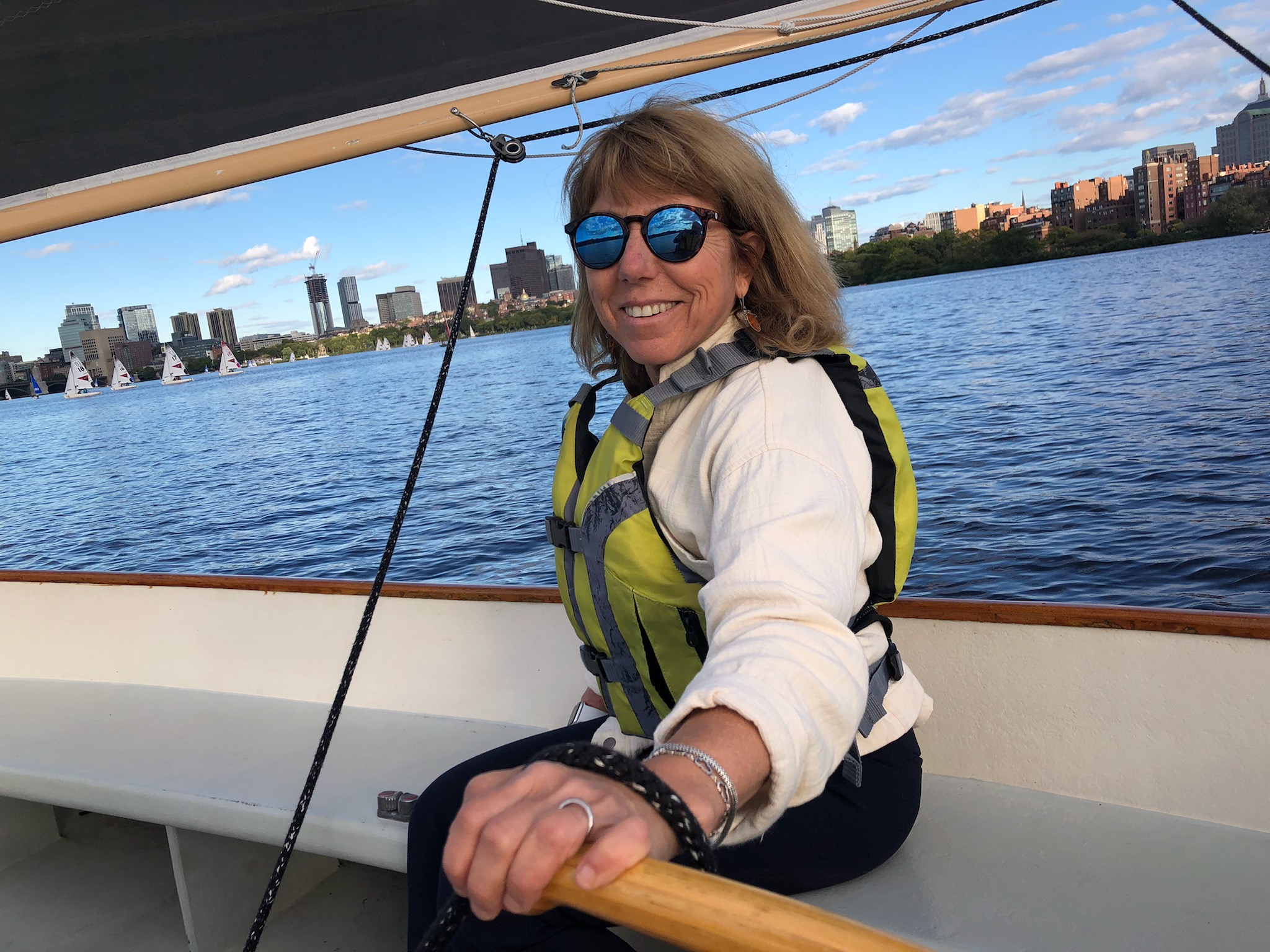
26 Oct Wind on My Face
Well, not too much wind, but it sure felt good.
A month ago, Steve and I took our first post-Covid trip by plane. We spent a weekend in New York with our son Danny and his girlfriend Dhivya, and then a week in Boston where we stayed with Steve’s mom. There, we also did a bunch of work for Stroke Onward. Among other things we joined the first in-person meeting of the BU Sargent School Clinical Advisory Board; presented to Sargent School students assembled by Craig Slater as part of their Interdisciplinary Professional Education (IPE) Program, and explored potential additional collaborations with both Liz Hoover at BU and Mike Boutin at MGH-IHP.
On Friday afternoon, we had a window of unscheduled time, so we drove to the MIT sailing boathouse on the Charles River. I had sailed for MIT for four years when I was an undergraduate there. The place was abuzz — it was recently renovated with extra space, and among other things, they now have fantastic waterfront space for student groups to host events — the BBQ was sizzling. And… the sailing teams were coming and going as it was afternoon practice hour.
We got to chatting with Fran Charles, head of the MIT sailing program and team, and he said “want to take out a boat?” He barely finished his question when I blurted out an eager “YES!” We’re talking about small boats, referred to generically as Dinghies. They have lots of racing boats — Tech Dinghies, Fireflies, Flying Juniors (FJ’s) and more. We took a Lynx Catboat, one of their more stable boats, used for recreational sailing mostly by MIT students newer to the sport. Steve was a tad apprehensive. I was not.
My right hand doesn’t work, and I walk with a limp, so Steve helped me onto the boat. It was pretty stable and I easily stepped across to the far side, where I wanted to sit. I grabbed the tiller and the main sheet. No way Steve was getting either of them. I used my mouth to hold the sheet when I pulled it in. I could hold the tiller and sail with one hand. Steve unclipped us, and we eased away from the dock.
The wind was light. I could barely feel it. But I looked across the river and could see from the water conditions exactly where the wind would pick up. We moved slowly at first. As we approached the wind line, my heart accelerated with anticipation. I knew it wasn’t going to be much, but when the puff hit the sail, and my cheeks, I had a rush of exhilaration.
I could smell the Charles River. Not the yucky smell it had – when I sailed – for MIT — it’s so much cleaner now. If I closed my eyes, I could tell you, from the smell, it was the Charles River.
It felt like coming home. Like this is where I belong. I knew where everything was and where everything was supposed to be. I heard the familiar sound of water against the hull, and wind on the sails. I glanced at the sail constantly, instinctively, pulling in or letting it out to avoid luffing. I felt the wind in my hair – on my cheeks. On my cheeks — my cheeks hurt – I was smiling so much. Can you smile “too hard”?
I smiled at the teams practicing — from MIT, BU and Harvard — as they worked to perfect their turns around buoys in the water. It’s a move I practiced thousands of times — overweighting one side of the boat to the verge of capsizing, then jumping across so it snapped the other way, making the boat turn faster around the buoy. Memories were flying through my mind. Great Lakes Yacht Club on Lake Saint Clair, where I started sailing dinghies at 10 years old. In high school, traveling from Detroit to regattas from Montreal to Florida. And then sailing for MIT, going to the nationals my freshman year. I guess it’s not surprising I was feeling at home in a dinghy.
Over the past few weeks, I confess I’ve thought about how I can’t do those turns anymore, and will never sail like I used to. But on that beautiful Friday three weeks ago I was in the moment — the joy of being on the water, the comforting feel of a boat under my feet, the wind on my cheeks. When I slip into “what used to be” I try to remember that afternoon, and usually the smile returns to my face.
It struck me that my 30 minutes on the Charles was a good metaphor for life after stroke — or life with disabilities caused by any trauma. I can’t do all that I used to do. I can’t do so many of the things I loved to do. But there is so much that I can do. And that can include many of the things that are really most valuable to me. The more I can focus on how to enjoy what I can do, how I can create meaning and purpose in my life despite my disabilities, the more effective I can be at enjoying life and contributing to the lives of others.

Sorry, the comment form is closed at this time.